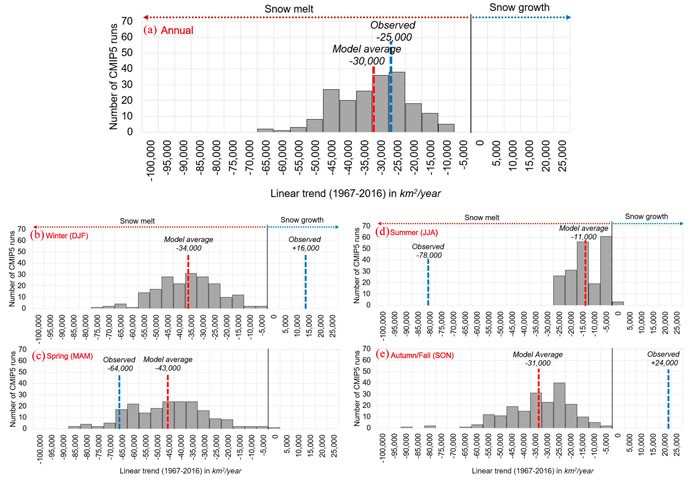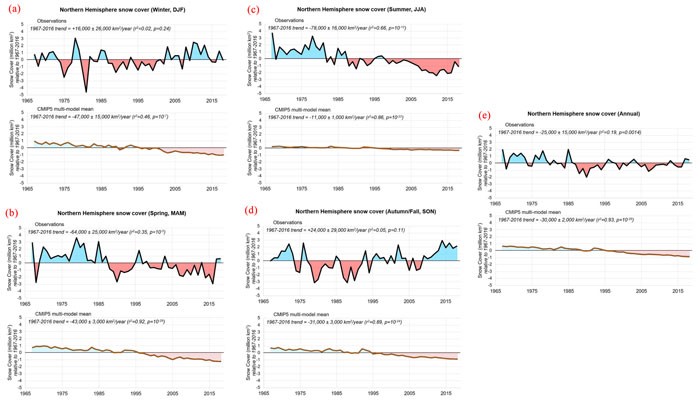From CO2Science: In a revealing paper Connolly et al. (2019) investigated the accuracy of climate models utilized by the IPCC to predict future trends in Northern Hemisphere (NH) snow cover. Since the mid-1970s, model-based estimates have consistently predicted this parameter should be declining in response to supposed CO2-induced global warming. But is it?
Paper reviewed: Connolly, R., Connolly, M., Soon, W., Legates, D.R., Cionco, R.G. and Herrera, V.M.V. 2019. Northern Hemisphere snow-cover trends (1967-2018): A comparison between climate models and observations. Geosciences 9: 135, doi:10.3390/geosciences9030135.
Connolly et al. address this question by examining observed changes in NH snow cover extent over the period 1967-2018 and then comparing them to changes predicted by 24 climate models (in a total of 196 model runs) from the Coupled Model Intercomparison Project Phase 5 (CMIP5). The five-decade study window was selected because it represents the full duration of available satellite-derived records of NH snow cover.
Results indicated that trends in annual NH snow cover were fairly similar when computed for both the observational record and as an average of all model runs -- declines of 25,000 km2/yr over the 52-year period for observations and 30,000 km2/yr for the models (see Figure 1a). However, that is pretty much where the similarities end. As shown in Figure 1b-e, large discrepancies between models and observations exist when comparing snow cover trends by season. For spring and summer, the observed trends in snow cover decline were much stronger than that predicted by the model average: -64,000 km2/yr (spring observations) vs -43,000 km2/yr (spring model average) and -78,000 km2/yr (summer observations) vs -11,000 km2/yr (summer model average). In contrast, trends in snow cover for fall and winter were not just dissimilar in magnitude, they were opposite in sign; models predicted declines of -31,000 km2/yr (fall) and -34,000 km2/yr (winter), whereas observations revealed snow cover gains of +24,000 km2/yr (fall) and +16,000 km2/yr (winter).
Beyond the discrepancies listed above, Connolly et al. go on to further demonstrate that the models fail to capture the nonlinearity inherent in the snow cover data. Figure 2 illustrates as much by presenting paired plots of observational and model-predicted snow cover values on a seasonal and annual time scale over the 52-year period of examination. As seen there, the model-predicted values fail to capture the variability and periodicities that exist in the observational data, instead showing continual declines in snow cover across the full length of the records. Connolly et al. conclude by offering several explanations as to why the models behave in a manner that is inconsistent with the observational data.
In concluding their paper, the researchers state the obvious, offering “we recommend that the climate model projections of future and past snow-cover trends should be treated with considerable caution and skepticism,” adding that “it is important that [policy makers] planning for future changes in snow cover do not rely on unreliable projections.” And that is good advice to end a very important and revealing study.

Figure 1. Distribution of linear 1967-2016 Northern Hemisphere snow cover trends for 196 CMIP5 simulations for (a) winter, (b) spring, (c) summer, (d) autumn/fall, and (e) annual averages. The observed trends for each season (or yearly average) are indicated with dashed, blue lines in each panel. Source: Connolly et al. (2019).

Figure 2. (a) Winter, (b) spring, (c) summer, (d) fall and (e) annually averaged trends in Northern Hemisphere snow cover (relative to 1967-2016) according to observations and the CMIP5 multi-model mean. The uncertainty ranges associated with the linear trends correspond to twice the standard error associated with the linear fit. Source: Connolly et al. (2019).



I post this not to be argumentative, but merely to point out that the science is not as well understood as many would have you believe. If the Earth warms, that should increase the amount of water vapor in the hydrological cycle, and it would stand to reason that this would increase snow cover. Predicting less snow cover due to global warming may have missed an essential point. Conversely, if the Earth cools, there might be less snow cover. Increased snow cover increases the Earth's albedo, i.e., the amount of energy reflected from the Earth back to Space, which would then cause cooling. There may be a feedback loop where higher temperatures lead to increased snow cover which would then in turn cause lower temperatures. My point is merely that the people who claim the ' science is settled ' are just wrong about that. We really don't well understand these mechanisms. Ask any honest scientist and they will tell you ' we need to do more research ', which may sound like a pat answer, but is true. As the science is not ' settled ', policy makers should adopt prudent measures and policies in terms of energy use and production rather than assuming harmful effects which to date have not occurred.
Your point is well taken. For me, the most telling symptom of manipulative chicanery is the artificial "adjusting" of the empirical data so the models can look like what the prevaricator want them to look like. That is not "SCIENCE" and it is not anything resembling the "scientific method".
GIGO!!
Well of course it does NOT matter whether the science surrounding Global Warming, is accurate or not.
From a government point of view, having legislated policy's that say there is a global warming crisis coming, the bureaucrats will work hard to support that contention, and the reality (whatever it turns out to be ) matters not at all, as public servants are required to support government policy.
This theoretically provides a moral dilemma for scientists who are public servants in that the scientific method demands certain standards of professional honesty, integrity and accuracy, whereas government employment demands obedience to policy or resignation.
I dont recall many resigning, so i suggest they prefer their paycheck and compliance.
There are some good examples of this to be seen with Australian Senator Malcolm Roberts questioning the CSIRO in senate estimates.